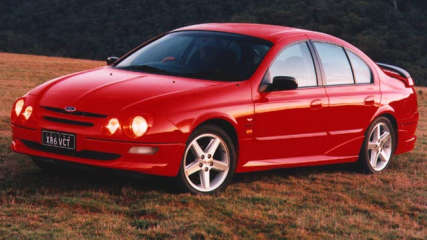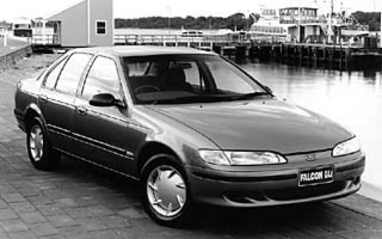Used Ford Falcon review: 1992-2000
By Graham Smith · 21 Oct 2003
Before the hot XR6 was unleashed in 1992, fast Fords were V8-powered. So the six-cylinder sports sedan came as a surprise to everyone. The XR6 was a bent-eight beater, but it was much more than that. It was not only fast, it also handled beautifully and was comfortable.Had we known then what we later found out about Tickford, now called Ford Performance Vehicles, it wouldn't have been such a surprise. The EBII XR6 was the first glimpse of Tickford's ability to produce a refined sporting sedan that did everything well. It had often been the case with Aussie-built muscle cars that power was everything.That relentless pursuit often came at the cost of handling, ride and comfort, but Tickford brought a European approach which balanced power and road manners. Another surprise came in the styling, which was neat and attractive, without being look-at-me in the way of most other muscle cars. But if the XR6 was rather reserved in appearance terms, there was nothing reserved about it when it hit the road.THE XR6 was based on the EBII Falcon S, a sportier version of the family four-door sedan. The engine was the Falcon 4.0-litre single-overhead cam unit, an effective but rather harsh and lumbering lump. But it had come under the spell of the engineers at Tickford Vehicle Engineering, Ford's performance partners who started working with the men from Broadmeadows in 1991.By the time Tickford was finished tinkering with the Falcon's head, cam, valves, valve springs, exhaust system and electronics, the fuel-injected six was slamming out a massive 161kW at 4600 revs and 366Nm at 3650 revs. And all of that while running on regular unleaded.It was enough to have the 1529kg sedan sprinting to 100km/h in 7.5sec. The standing 400m sprint was covered in 15.5sec and it had a top speed of 223km/h.They were numbers that had the V8 brigade looking back in horror, but they didn't tell the whole story, which was that the XR6 had plenty of low-end and mid-range punch which made it very driveable.Gearbox choices were a five-speed manual and a four-speed auto which delivered the power to the live axle LSD rear end running a low 3.45-ratio axle which helped it jump out of corners.Back in 1992 Ford was committed to a live rear axle, but Tickford's engineers managed to tame it quite effectively. The XR6 rode lower and had a package of gas shocks, stiffer springs, larger anti-roll bars front and rear which, coupled with revised front-end settings, made the steering precise and responsive and brought an assured balance to the handling.Despite still having 3.1 turns lock-to-lock, the Falcon could be pointed at corners with confidence it would hold its line right through to the exit. There was still some evidence of the roll oversteer associated with the Ford rear end, but it would quickly settle under power.To match the go power, the XR6 was equipped with decent disc brakes, which worked in tandem with ABS. The XR6's rolling stock consisted of 15-inch five-spoke alloy wheels and 205/65R15 Michelin tyres. It stood out from the Falcon crowd with body-coloured bumpers and mirrors, red rub strip inserts and a small rear wing.Inside there were reshaped sports front seats which were more supportive and comfortable than the regular Falcon ones. They had velour facings, were highlighted with red piping, and there was also a leather-trimmed Momo sports steering wheel and gear shift knob.ALL alloy-headed Falcon sixes have a problem with head gaskets. It's not unusual to blow them at any time, but they seem to be more prone to it from about 80,000km onwards.Cylinder head reco experts say there is a problem with coolant circulation, which leads to a steam pocket at the rear of the head which can then lead to gasket failure and cracking of the head.Some even relieve the problem by tapping into the head and allowing the coolant to flow from the problem area through an external pipe. Suspension bushes can be a problem at higher mileage, and require replacement to restore the XR6's renowned handling.Falcon electrics can also be troublesome. Body control modules are a headache and replacements are expensive, so check the system's operation as thoroughly as you can. Engine oil leaks are also a common problem. Look at the front cover and power steering pump.MARK Harris bought his white XR6 new in 1993 and has driven it sparingly. It has just 51,000km on the odometer and is driven only on weekends, when he enjoys it very much. Dion Coughlan bought his three years ago when it had done 175,000km. He has added another 80,000km, and says he drives it hard.It has had a near-death experience when it was hit by a bus. Despite a few rattles, Dion says it still performs well. Apart from minor things such as a fan belt, the only things Dion has had to replace are the front suspension bushes.







